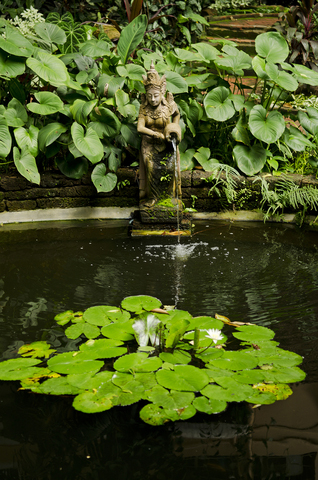Ponds on the Level

More and more people are enjoying the way ponds and watergardens help them keep in touch with nature, enjoy tranquility and slip into peaceful reflection. But these watershapes are small ecosystems and can pose a range of challenges – some of them, as we shall explore here, related to maintaining proper water levels.
The average pond can lose its water in a number of ways, anything from small leaks or wicking from waterfalls to evaporation or small animals taking their share. Pond professionals and pond owners all know this, of course, but most rely on manual refilling methods – that is, a bucket or a nearby garden hose – instead of devising more elaborate filling systems.
To be sure, the classic manual methods are tried and true, but some have sought better, more reliable ways of keeping the water at the right level while also avoiding a few of the less-considered hazards that come with the usual approaches.
Failure Factors
Experts, in fact, will tell you that filling a pond with a hose can lead to disaster. First there’s the danger of overflowing the pond or even flooding the yard, which sometimes occurs when the pondkeeper (whether the homeowner or a pond-service professional) gets distracted during the filling process. Using a timer can help, but this requires a basic knowledge of the hose’s flow rate as well as the required volume of fill water.
As an alternative, consider the use of automatic filling systems that sense the level of the water and refill it as needed without the pondkeeper having to do anything at all. The great thing here is that the homeowner can leave on a vacation or business strip without having to worry about the pond level falling to a troublesome degree.
The knock on these auto-fill systems is that they’re so good at what they do that they can mask leaks that might otherwise be detected through changes in filling patterns. In such cases, the system might end up introducing a steady or near-steady stream of chlorinated tap water to the pond, possibly to the detriment of both plants and fish.
First, it should be understood that adding chlorinated water to a pond with fish is never acceptable. True, small amounts of chlorine will not be immediately harmful, but even under the best circumstances the gas takes a while to dissipate – and this is as true of water from a hose or bucket as it is of an auto-fill system. In this instance, however, an auto-fill has the advantage because it can easily be rigged with an inexpensive, long-lasting, in-line chlorine filter. This is a possibility that’s not usually considered with a hose or bucket.
Second, it is true that a basic auto-fill system can mask a leak. That’s why it’s advisable to use a professional-grade system that sets off an alarm if a change in fill patterns might indicate a leak. These units also let the user know when the filling system is active so the user can determine how often it is being activated. As I see it, this is the best way to keep the surface area constant and thereby protect fish and pumps from instances of low water caused by evaporation and/or leaks.
Moving Forward
In today’s marketplace, various systems are available that will relieve a pondkeeper of the task of monitoring and worrying about a pond’s water level. In the next article in this three- part series, we’ll roll through what’s available, define the distinctions and build an information base. Then, in the third part, we’ll dig deeper and evaluate these systems and how they’re used.
Hollye G. Merton began building ponds while in elementary school, inspired by her father’s construction of a Japanese-style pond in their backyard. In 2009, she founded Aquility Systems, the manufacturer of the Level Waters automatic water-leveling system. She may be reached at hmerton@aquilitysystems.com.










